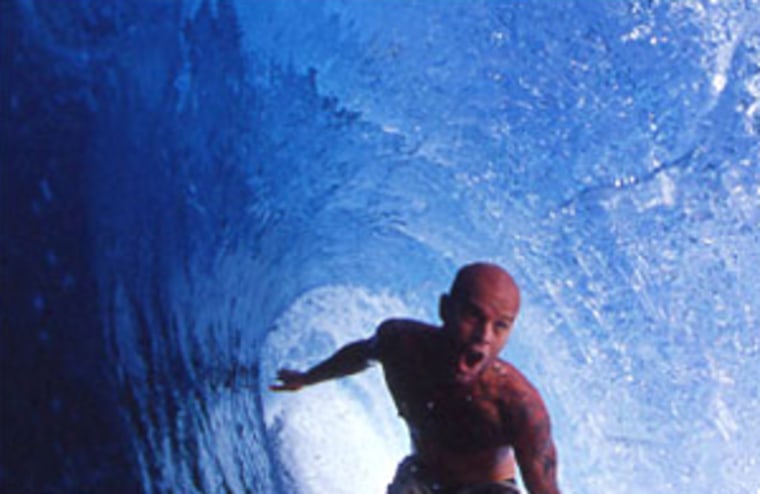Nem, a crewman whom we’ve renamed Sugar Bear, sturdy with a pronounced buddha’s belly looming happily over his stout legs, casually wearing an unknowing smile that cancels the threat of his giant’s frame, effortlessly raises the boat’s 40 horsepower prop so that it barely skims the ocean’s surface. The tide is dangerously low; a thin veneer of water just covers coral heads sprouting out of sandy keyholes, and our skiff hovers precariously over the reef. We sit quiet and unmoving as wispy patches of clouds intermittently block the full moon and the humming propeller cuts a slow path. Betraying my instinct to let go of this incredible experience, I take one last glance at the island. In the small church the lanterns still burn dimly, the voices still harmonize into a single profound song. The bright sounds fetter us to the village, but we reluctantly push away.
Our group is an unlikely patchwork of professional surfers and photographers brought together by our Fijian guide Ian Ravouvou Muller, and we had been summoned to the village this evening to meet the local people of Matuku. Five days ago we gained permission from chief Ratu Alipate Baleilakeba to surf this island’s forbidden reef passes, a collection of virgin waves that no expedition had fully uncovered. Tonight we had come to extend our own offering: a black garbage bag teeming with clothing, sunglasses and footwear, a box of medical supplies, a modest stack of books and magazines, a haul of photographs, and snacks for the children. An hour before, this assortment of gifts had looked substantial, but as the villagers, hundreds of them, poured through the church doors to sit with us on the frond-covered floor, the plastic sack seemed pathetic and inadequate.
As weak light from oil lanterns cast dancing shadows on the church’s four walls, and we took seats on the floor with the local people, they introduced themselves for the first time, admitting that they’d been watching us surf for days from the secret windy heights of their verdant island.
They plied us with kava, a drink of silt water distilled from a native yagona root, equal parts ceremony and sedative. They offered coffee and cakes. And then they sang—first one lone tenor, then an erupting chorus of baritone measured by synchronized hand claps resonating throughout the church. I turned to Ratu Alipate. I asked him what the song meant. “They sing of Matuku. The song says we are good, we welcome people. Come to Matuku.” He is over-exuberant and thirsty for more visitors like us to infuse the island with new life. A plastic bowl separates our party from four plump women wrapped in grass skirts, wearing lavishly crafted leis around their necks and vibrant headbands in their hair, sitting cross-legged on the thatched mats of the church floor, performing the meke, arms dancing across their giant torsos. One by one, we take turns depositing our Fijian bills into the suppliant dish, bridging the cultural divide with each slip of paper currency we offer. The sound is beautiful, the sentiment lovely.
Before long, we’ve given all we can. An island with a history of resistance has proven itself unequivocally generous, and we’ve returned in kind, but the 21st century can’t be ushered in overnight. As the charming nuances of island life unveil themselves this evening, it’s apparent that these people never knew the resources that existed in their waves, and are excited at the thought of more benevolent journeyers like us.

Alipate speaks to his people in Fijian. The room settles, his voice the only sound. Occasionally, he taps me on the knee as though in explanation. I pick out the word “magazine” and understand. His islanders, and he himself, haven’t seen outsiders on Matuku before.
Too soon, it’s 11 o’clock, time to begin our long northern voyage back to Viti Levu, Fiji’s main island. I glance around the room one last time. The oil in the lanterns low, the light weak. The people thank us, the songs continue.
Barefoot, I walk outside, across the tall grass, the wind carrying on it the scent of the ocean, refreshing after the stuffy heat of the church. Soon we’re on the beach, exchanging goodbyes, wading through knee-high water, sinking in the sea grass, feeling with our feet a way to the boat.
Aboard the skiff, prop whirling dutifully, my heart sinks. I look at Sugar Bear—tall, thick, strong, scarred, amiable—looking every bit worth his name. He smiles faintly, and queries me. “Good?” I nod in agreement. Good indeed.
Alipate speaks to his people in Fijian. The room settles, his voice the only sound. Occasionally, he taps me on the knee as though in explanation. I pick out the word “magazine” and understand. His islanders, and he himself, haven’t seen outsiders on Matuku before.
Too soon, it’s 11 o’clock, time to begin our long northern voyage back to Viti Levu, Fiji’s main island. I glance around the room one last time. The oil in the lanterns low, the light weak. The people thank us, the songs continue.
Barefoot, I walk outside, across the tall grass, the wind carrying on it the scent of the ocean, refreshing after the stuffy heat of the church. Soon we’re on the beach, exchanging goodbyes, wading through knee-high water, sinking in the sea grass, feeling with our feet a way to the boat.
Aboard the skiff, prop whirling dutifully, my heart sinks. I look at Sugar Bear—tall, thick, strong, scarred, amiable—looking every bit worth his name. He smiles faintly, and queries me. “Good?” I nod in agreement. Good indeed.
Like any great expedition, this one began by degrees—a phone call, an email, an exploratory trip, a confirmation, a group arriving at Nadi airport in the night, taking pause from various scattered journeys to be a part of something that none of us could have fathomed.
I was perhaps too forthcoming in stating on my immigration form that my destination was the Lau group, a collection of tiny islands in Southeastern Fiji that enjoy the special characteristic of being pretty much off-limits to any non-native. It was a note that my customs officer, in flower shirt and sulu (but nonetheless a government official) did not ignore. “Lau?” Yes. “What are you doing there?” Surfing. A quizzical eye. He slammed a stamp into my passport and handed it back. “Be careful.”
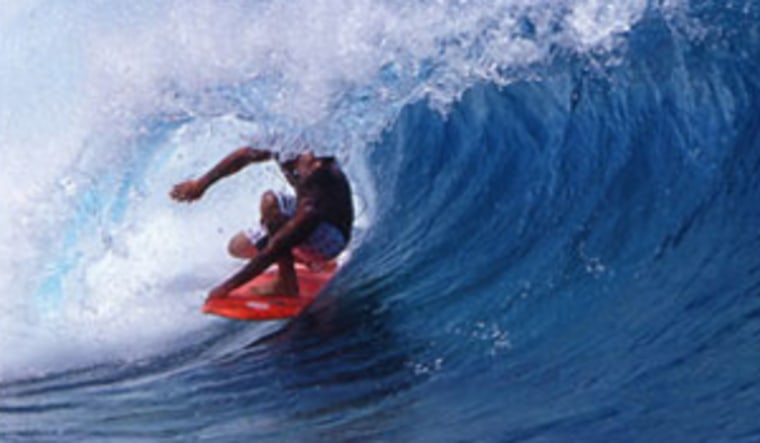
For good reason. One of the last western expeditions through the Lau group was the U.S. Exploring Expedition in 1842. Then, Charles Wilkes led a fleet of ships on a two-month tour of what he dubbed the “Cannibal Isles.” After he’d charted the area, he promptly left, citing his dog, a giant Newfoundland named Sydney, as perhaps the only reason he’d survived. In the 1960s and ‘70s, smugglers found the Lau group to be a suitable place to run contraband, burying large quantities of cocaine and other drugs in the sand where their associates would later dig up the goods and complete the task of distribution. Around the time that the Island of Tavarua was being founded as an exclusive surf resort on the basis of Fijian fishing rights, islanders in the Lau group were digging in the sand for turtle eggs when they came upon 12 fuel drums on the shore. Extricating the barrels, they found not crude oil, but container after container filled to brimming with a white powdery substance. Showing fortuitous restraint, they sniffed not a line of the stuff. All boats were promptly banned from entering the Lau group. A people renowned for cannibalism only furthered their reputation as unwelcoming hosts.
It was with this understanding that I accepted the warning of my customs officer, and silently decided not to tell anyone else where I would be headed. In point of fact, the only reason for my heading anywhere near the Lau group was a Fijian man by the name of Ian Ravouvou Muller. Rooted in Fiji, Ian’s heart is for his people, his pride for country pouring out of an imposing figure and solid character, both of which call to mind the silent strength of a Fijian kauri tree. He spent eight years of his youth living in California, and so he has a better understanding of western culture than most Fijians, which has caused him special concern for these islands, the last outposts of the native culture. Though the Lauans have a checkered past with visitors, their poverty is increasingly alarming in the face of Fiji’s rapid development, and Ian’s sense is that it is only a matter of time before wealthy capitalists flaunting stacks of cash will bring their loaded briefcases to bear on these islands. But as his own crusade has proven, it’s not that easy.
Because fishing is a means of subsistence, individual tribes retain proprietary domain over their waters, but reef rights are both the boon and blight of Fiji. To considerable success, entrepreneurs have proffered fat sums of U.S. dollars for exclusive rights to waves, making surf resorts of whole islands, and earning money on the backend by charging a single surfer multiple thousands for a week’s worth of waves. Certainly these same entrepreneurs have improved the standard of living for the local people by providing education and medicine, but they have forever altered a way of life.
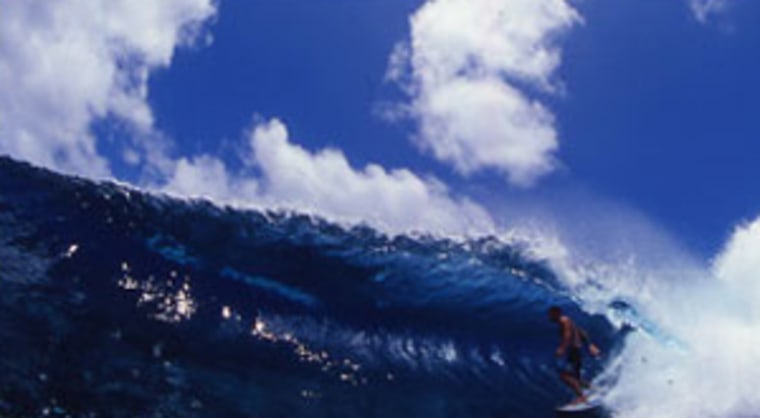
In Lau, however, most of the islanders resist change, but still endure great need. Most earn their money from packing copra, the fluffy innards of a coconut used to produce oil, an enterprise that pays 15 cents for every five kilogram bag of the light substance. Schooling runs 20 dollars per term, three terms per year. And, unfortunately, education is not the only need of the Lauan people. A history of isolation has left the islands self-sustaining but entirely out of sync with a society rapidly encroaching on their existence. A boat comes once per month to Matuku, the same boat every time, docking off the same wanting slab of cement that plays the role of a harbor, taking the same passengers, the same possessions, the same desperation with each slip off the horizon.
Through family blood ties to the island, Ian has gained permission from the Lau Provincial Council to surf on their reefs. In exchange, Ian is donating a portion of the proceeds from each of his Viti Surf Legend tours, infusing the islands with educational and medical supplies, as well as establishing a trust fund to help send children to school and assist in village community projects.
Despite the obvious needs of his island, Ratu Alipate is happy when I sit down to talk to him about our being there. He sucks up all the air he can marshal through his nose, drawing breath into his chest, and tells me that his people are happy.
I ask if he’s afraid that surfers could taint his society. He looks at me, dumbfounded. “Ian is good person. You are good person. Matuku…happy to have you. Happy to have Ian.” If he is aware of surfing’s history of colonization, he hides it well. What he knows too well is that there is a disconnect between the financial needs of the island and the people’s desire to keep their traditions in tact, and he’s hoping that visitors to his island can lend some low-impact stability to what is now a wobbly balance.
Notwithstanding the warm welcome, every time Ian returns to Lau, he and all of the surfers with him must engage in a sevu sevu, a traditional ceremony wherein he asks special permission to surf near the islands. We first met the chief during one of these ceremonies on a gray Monday morning, after seeing from the top deck of our boat, the Tui Tai, that clean southeast swell was lighting up a series of outer reefs on the horizon. Quelling an instinct to dive headlong toward the waves, we wrapped ourselves in sulus and motored to the nearest village to meet with Alipate, and to ask permission to surf his waves. Bumping along the shore, he met us at the skiff and took us to his home. There, we formed an oblong circle, sat cross-legged on the wood floor, sweating in the South Pacific midday. A crewman spoke in Fijian on our behalf. Alipate accepted our gifts, the most appreciated seeming to be the large kava root wrapped in newspaper, and blessed our voyage.
“You wasting my waves!” Ratu Alipate, big, thick, looking thoroughly modern in his recently gifted F.A.B. sunglasses, is new to the sport of surfing, but he’s already displaying a commendable mastery over the arts of localism and heckling. Lounging on his own skiff, dismayed at a set wave gone unsurfed, he’s feigning hostility about the freshly cracking top-to-bottom barrel going unridden.
Fortunately, the chief remains silent when I stroke feverishly into the next wave and knock my ankles together, miss my board, wrap myself in the lip and tumble adroitly with the crashing whitewater to the jagged reef below, watching helplessly as my vision shifts from brown reef to blue sky and back again while the roll unfolds itself, bracing myself for the coral jamboree that will play out on my body. The pain first localizes itself to my left thigh—a dull ache and a series of sharp cuts—then diffuses to the knifing slash of the reef on my feet as I flop helplessly across its piercing jags, but the enduring damage is done to my ego as I gingerly paddle back outside to try my hand again.
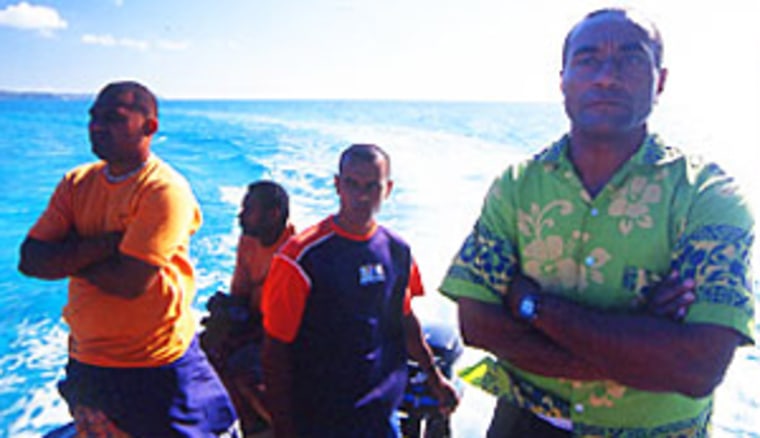
This wave we’ve found, Vinaka’s (literal translation: thank you), is proving to be a fickle mistress. Deepwater swells wrap around a deceptively attractive point that’s breaking on dry reef, and the same surges are pushing here over coral heads that are covered by only inches of water. The only place to hide from this powerful wave is in the tube, and if you’re not sure that you’re coming out every time, it’s a dicey proposition. By the end of the trip, my feet were reduced to grated nubs.
But Vinaka’s isn’t the only wave we’ve found. Fiji’s main island of Viti Levu has a native surfing population of about 50, and the vast majority of surfing tourism done here is restricted to two islands, leaving much of Fiji’s resources untapped. With one of the largest living reef systems in the world, it offers myriad possibilities, and ours was one of the first expeditions to find waves outside of the main islands, definitely the first in the Lau group. On Matuku alone—an island that takes only two hours to circle—we found four new waves—the best given the conditions was Vinaka’s, but more user-friendly rides availed themselves. There was Ratu’s (a mirror image of Vinaka’s), Chuckie’s (a tubing righthand speed-track cum launch ramp), Freight Trains (a racy left that peeled for 100 yards), Church (another left breaking directly in front of the village), and on the last day, on a triangle reef in the middle of the South Pacific, we found another left, which we named Sugar Bear’s, in honor of our new friend.
Even with all of our discoveries, we’d only scratched the surface of Fijian potential. There are literally dozens of islands dotting the group, and with only one charter authorized to motor throughout the region, it will take years of study to understand them.
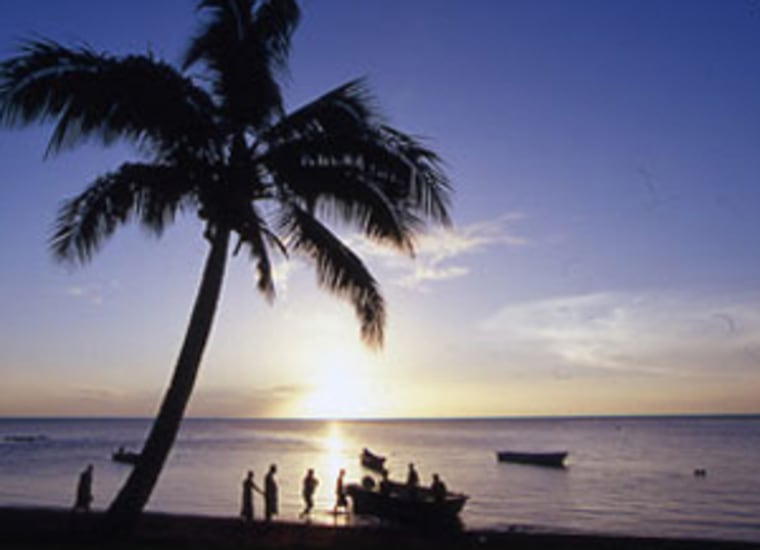
Dwindling hours and impending conclusion. Sixth day of a seven day wave binge, rattled from days of rolling on the reef, cut and scraped, punctured and prodded, nagged by aching knees and tender feet, sore with bruised muscles and a damaged ego, nursing ailing ankles and tired from constant duress, stung by sealice and bitten by nighttime mosquitoes, itching from heat rash, sunburned and peeling, mind awash in the murky sleep deprivation that accompanies any good boat travel, haggard with one-week’s beard growth and dirty, unkempt hair, wretched, stinking, festering, I sit on the top deck of the Tui Tai in the afternoon light and look out to the grinding left hander and the reeling right, each with a flock of surfers gerrymandering a takeoff zone in search of one last vestige of Fijian reality before the long boat ride back to Suva—and I absorb our days of exploration.
Tonight the islanders will hold a ceremony for us, and we will leave under cover of night. In the small hours of the morning, as we make our way back to Viti Levu, our ship will rock fitfully in an angry tempest, but we will arrive safely at Suva harbor by dawn.
The essence of our experience will remain unchanged. To these islanders, we will always be the first ambassadors of the sport of surfing, the broad-smiled young men who wanted to play in the waves that they had watched break vacantly for years, the first pale-skinned travelers who came bearing a new perspective, and perhaps a new way of life. In this part of the world that surfing’s hand had yet to touch, we founded a relationship between surfers and the people beyond the shore. A people thirsty for the most basic things in life offered us a trip to the well with each crystalline wave they let us ride, and in return, we were the first to give drink to an island surrounded by water.
For more than four decades, Surfer has been internationally recognized as a leading publication and trendsetter for the surfing community, and remains the biggest and most influential surf magazine in the world.
